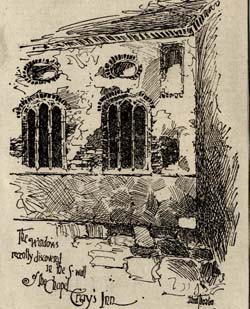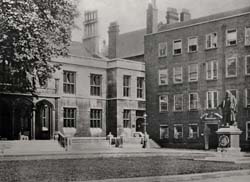Explore the timeline for notable dates through the Inn’s history.
Beginnings
 The first habitation known to have been on or close to the site of the present Hall was the Manor House of the ancient Manor of Purpoole (also Portpoole), meaning “the market by the lake”. The market was the cattle market, the present site of the Prudential Insurance Building in Holborn. The lake or lakes were the area to the north and east of Purpoole Lane (to the east of Gray’s Inn Road), where the land can be seen to fall away. The Manor House was the property of Sir Reginald de Grey, Chief Justice of Chester, Constable and Sheriff of Nottingham, who died in 1308. None of the Inns of Court has a proven year of foundation. Though some have later charters, none of the Inns were founded by charter, ordinance or endowment and there is no extant record of a first lease. Indeed the records of the Inn do not commence until 1569.
The first habitation known to have been on or close to the site of the present Hall was the Manor House of the ancient Manor of Purpoole (also Portpoole), meaning “the market by the lake”. The market was the cattle market, the present site of the Prudential Insurance Building in Holborn. The lake or lakes were the area to the north and east of Purpoole Lane (to the east of Gray’s Inn Road), where the land can be seen to fall away. The Manor House was the property of Sir Reginald de Grey, Chief Justice of Chester, Constable and Sheriff of Nottingham, who died in 1308. None of the Inns of Court has a proven year of foundation. Though some have later charters, none of the Inns were founded by charter, ordinance or endowment and there is no extant record of a first lease. Indeed the records of the Inn do not commence until 1569.
In 1370 the Manor House is described for the first time as “hospitium” (a hostel). That change of description suggests a gathering of lodgers at the Manor House by 1370 and it seems probable that the “hospitium” was a learned society of lawyers because, only eighteen years later, in 1388, two members became Serjeants.
The reason why Holborn became a district of lawyers seems to have been a decree of Henry III, dated 2 December 1234, that no body providing legal education should be located in the City of London, which had the effect of moving the legal profession to the boundary of the City closest to Westminster and the courts.
For many centuries it had been the view, held with varying degrees of confidence, that the starting point of the Inns of Court was a writ of Edward I made on the advice of his Council in 1292. In 1285 the King went to France to attend to the affairs of his Duchy of Aquitaine; he stayed away for nearly 4 years and during that time many of his judicial and administrative Officers in England engaged in corruption. On his return the King set up a commission to inquire into the whole matter and many of the judges were disgraced and dismissed.
16th century
 In the fifteenth century there were many more legal societies or Inns than the four Inns of Court that we know today. Those with the most active educational programmes attracted the brighter and more ambitious students, who in their turn became Readers and Serjeants. During this century there were more men called to be Serjeants from Gray’s Inn than any other Inn of Court.
In the fifteenth century there were many more legal societies or Inns than the four Inns of Court that we know today. Those with the most active educational programmes attracted the brighter and more ambitious students, who in their turn became Readers and Serjeants. During this century there were more men called to be Serjeants from Gray’s Inn than any other Inn of Court.
Today the governance of the Inns of Court is entrusted to the Benchers made up in the main from judges of the High Court and senior barristers. It was not always so. Up to the end of the sixteenth century the title of Bencher was accorded to those who judged the moots held in the Inns of Court. Benchers were not concerned with the control of the Inn’s affairs, that was left to the Grand Company – the Treasurer, Readers and Ancients.
During the sixteenth century the four Inns of Court prospered greatly. Not only were the judges closely connected with the Inns, but the prosperity of the Inns had attracted the support of the statesmen of the day. Edmund Dudley, a financial agent and adviser to Henry VII, was a fellow of the Inn until beheaded on the orders of Henry VIII in the first year of his reign. Thomas Cromwell, Henry VIII’s persecutor of the old religious order, was a member. He suffered the same fate for his excessive zeal later in the King’s reign.
As the sixteenth century advanced, prosperity attracted a broader culture to the Inns. Good manners, courtly behaviour, singing and dancing came to the fore. Hall was cleared for the galliard and colourful masques and revels were performed. The entertainment on occasions spread to street processions and river pageants. Perhaps the Inns were too successful in these pursuits, because they soon became fashionable places for noblemen and country gentlemen to send their sons. “Of Gray’s Inn” and “student of Gray’s Inn” merited inclusion in epitaphs on many tombstones. Many members had no intention of becoming barristers. Between 1561 and 1600 the average admittance to the Inn was 62, whereas the annual calls to the Bar were only 6. Nevertheless this has been named “the Golden Age” when Queen Elizabeth herself was the Inn’s Patron Lady; Lord Burleigh, the Queen’s First Minister, Lord Howard of Effingham, the Admiral who defeated the Spanish Armada in 1588, and Sir Francis Walsingham, the Chief Secretary who founded the Queen’s secret service, were all members of the Inn. It was not only from the Benchers’ table that the Inn took its fame.The Inn was renowned for its “Shows” and there can be little doubt that William Shakespeare played in Gray’s Inn Hall, where his patron, Lord Southampton was a member.
17th century onwards
Between 1680 and 1687 there were three disastrous fires at the Inn. That of 1684 was particularly grievous for it burnt the Library, which was then on the present site of No 1 Gray’s Inn Square, and that is probably when the Inn’s ancient records were lost.The fire on 21st January 1687 burnt up “5 staircases”. For the next hundred years or more, qualification for call to the Bar depended on eating dinners and on the recommendation of a Judge or a Bencher. By the 1840s the regulations had changed little from the 1740s except that taking the Sacrament according to the rites of the Church of England had ceased to be a condition of Call.
By 1846 it was being urged in the profession and in Parliament that students ought to receive a comprehensive legal education and that there should be uniformity of practice of Call to the Bar. In 1852 the Council of Legal Education was established and each of the Inns undertook not only to pay expenses but also to lend two classrooms. Twenty years later examination for Call to the Bar was introduced. The Council became housed in Lincoln’s Inn but following the 1939-45 War moved into purpose-built accommodation in Gray’s Inn Place and later expanded further into Atkin Building as the Inns of Court School of Law. Additionally, a need has been found for advanced advocacy training at the stage of pupillage. The Inn has led the way in introducing mock trials and advocacy training before the judges and senior practitioners of the Inn in addition to students’ moots and debates. This training is now compulsory for all pupils.
